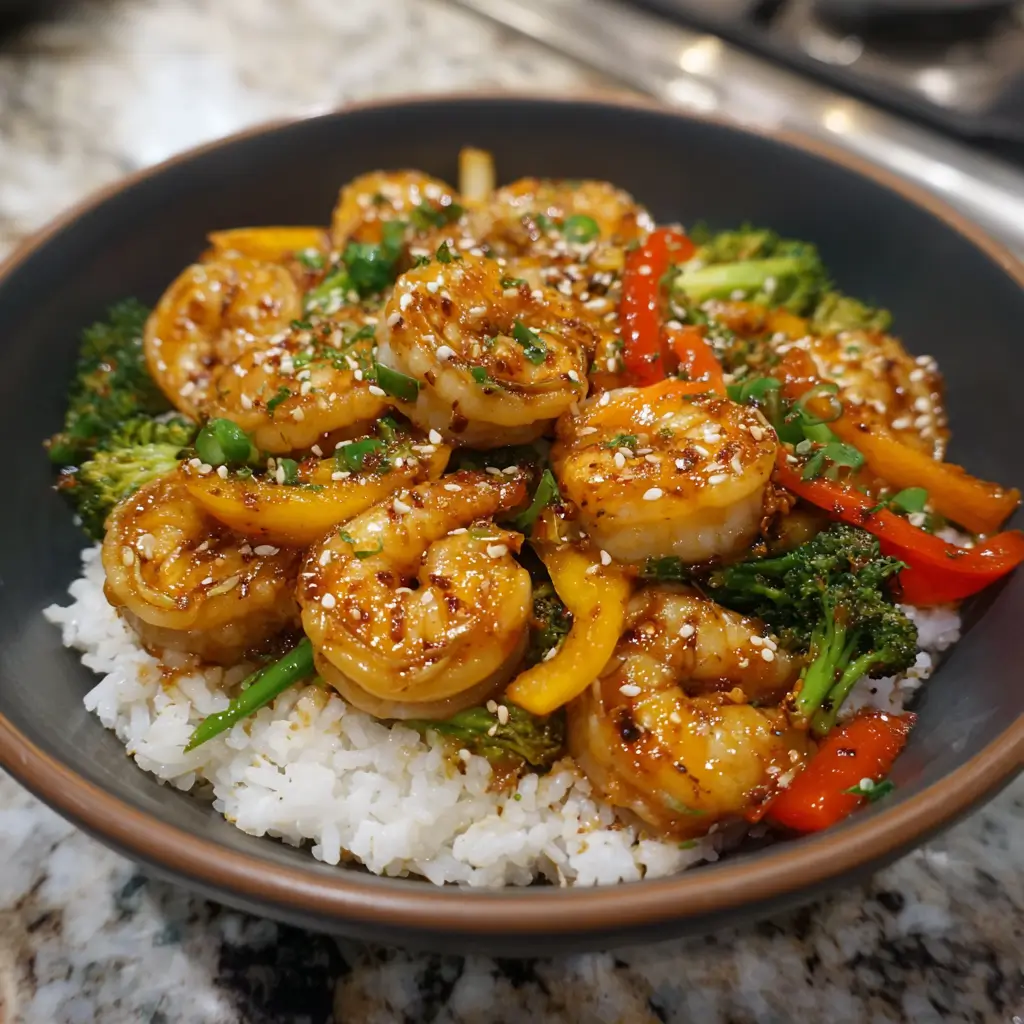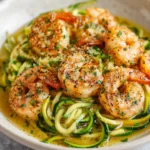Introduction
Teriyaki Shrimp Stir Fry is a vibrant, flavorful, and quick-to-prepare dish that brings together the best of Japanese-inspired cuisine with the convenience of a modern stir fry. Bursting with sweet, savory, and umami-rich flavors, this dish features succulent shrimp glazed in a glossy homemade teriyaki sauce and tossed with crisp vegetables over a bed of fluffy rice or noodles. Whether you’re looking for a weeknight dinner solution or an impressive meal to serve guests, Teriyaki Shrimp Stir Fry delivers on taste, texture, and visual appeal. Its balance of protein, vegetables, and complex carbohydrates makes it not only delicious but also nutritious and satisfying. With endless customization options and the ability to adapt based on dietary preferences, this recipe has become a staple in kitchens around the world.
The History
The roots of teriyaki can be traced back to Japan, where it originated as a cooking technique rather than a specific sauce. The word “teriyaki” comes from two Japanese words: “teri,” meaning luster or shine, and “yaki,” meaning grilled or broiled. Traditionally, fish—especially salmon or mackerel—was marinated in a mixture of soy sauce, mirin (sweet rice wine), and sake, then broiled or grilled until the surface developed a beautiful, glossy sheen. This method dates back to at least the 17th century during the Edo period, when soy sauce production became widespread in Japan.
As Japanese immigrants brought their culinary traditions to other parts of the world, particularly Hawaii and the West Coast of the United States, the teriyaki style evolved. In American and Hawaiian interpretations, the sauce became sweeter and thicker, often incorporating sugar, cornstarch, and ginger. It was commonly used not just for grilling but also for stir frying—a fast-cooking method popular in Chinese cuisine that quickly gained favor due to its efficiency and bold flavors. Shrimp, being a popular seafood choice, naturally found its place in teriyaki dishes, especially given its ability to absorb flavors quickly and cook in minutes. Today’s Teriyaki Shrimp Stir Fry is a fusion masterpiece, combining Japanese seasoning techniques with Asian-American stir-fry traditions, making it a beloved global comfort food.
Ingredients Breakdown
The magic of Teriyaki Shrimp Stir Fry lies in the harmony between its core components: the protein, the sauce, the vegetables, and the base. Each ingredient plays a crucial role in building layers of flavor, texture, and nutrition.
- Shrimp: Large or jumbo shrimp, peeled and deveined, are ideal for this dish. They cook quickly, remain tender, and soak up the teriyaki sauce beautifully. Fresh or high-quality frozen shrimp work well—just ensure they’re fully thawed if frozen.
- Soy Sauce: The backbone of the teriyaki sauce, soy sauce provides saltiness and umami depth. For a richer flavor, use low-sodium soy sauce to control salt levels, or opt for tamari if you need a gluten-free alternative.
- Mirin: A sweet rice wine essential to authentic teriyaki, mirin adds subtle sweetness and helps create the signature glossy finish. If unavailable, a mix of dry sherry and a bit of sugar can be substituted.
- Sake or Rice Vinegar: Sake enhances the complexity of the sauce, while rice vinegar offers acidity and brightness. Either can be used depending on availability and preference.
- Brown Sugar or Honey: Adds sweetness to balance the saltiness of the soy sauce. Brown sugar imparts a molasses-like depth, while honey contributes floral notes and extra gloss.
- Fresh Ginger and Garlic: These aromatics form the flavor foundation. Grated or finely minced, they infuse the sauce with warmth and pungency.
- Cornstarch: Used as a thickening agent, cornstarch gives the teriyaki sauce its velvety, clingy consistency that coats the shrimp and vegetables perfectly.
- Vegetables: Common choices include bell peppers (red, yellow, or green), broccoli florets, snap peas, carrots, mushrooms, and onions. These add color, crunch, and essential nutrients.
- Oil: A neutral oil like vegetable, canola, or avocado oil is best for stir-frying. Sesame oil can be added at the end for fragrance.
- Rice or Noodles: Steamed jasmine rice, brown rice, or soba noodles serve as excellent bases. Quinoa or cauliflower rice are great low-carb alternatives.
- Garnishes: Sesame seeds, sliced green onions, and chopped cilantro elevate the dish visually and add fresh, nutty, or citrusy accents.
Step-by-Step Recipe
- Prepare Ingredients: Peel and devein the shrimp, pat them dry with paper towels, and set aside. Wash and chop all vegetables into uniform bite-sized pieces to ensure even cooking. Mince the garlic and grate the ginger.
- Make the Teriyaki Sauce: In a small bowl, whisk together ½ cup soy sauce, ¼ cup mirin, 2 tablespoons sake or rice vinegar, 3 tablespoons brown sugar or honey, 1 tablespoon grated ginger, 2 cloves minced garlic, and 1 teaspoon cornstarch. Set aside.
- Blanch Vegetables (Optional): For crisper-tender veggies, briefly blanch broccoli or carrots in boiling water for 1–2 minutes, then plunge into ice water. Drain well before stir-frying.
- Stir-Fry Shrimp: Heat 1 tablespoon of oil in a large skillet or wok over medium-high heat. Add the shrimp in a single layer and cook for 1–2 minutes per side until pink and opaque. Remove and set aside.
- Cook the Vegetables: Add another tablespoon of oil to the same pan. Toss in onions, followed by harder vegetables like carrots and broccoli. Stir-fry for 2–3 minutes. Add softer veggies like bell peppers and snap peas, cooking for another 2 minutes until vibrant and crisp.
- Combine and Simmer: Return the shrimp to the pan. Pour in the teriyaki sauce and bring to a gentle simmer. Cook for 2–3 minutes, stirring frequently, until the sauce thickens and coats everything evenly.
- Finish and Serve: Drizzle with a half-teaspoon of toasted sesame oil for aroma. Taste and adjust seasoning if needed. Serve immediately over steamed rice or noodles.
- Garnish: Sprinkle with sliced green onions, sesame seeds, and optional cilantro before serving.
Tips
- Don’t Overcook the Shrimp: Shrimp cook very quickly and become rubbery if left too long on the heat. Remove them from the pan as soon as they turn pink and curl into a “C” shape.
- High Heat is Key: Use medium-high to high heat for stir-frying to achieve the signature “wok hei” (breath of the wok)—a slightly smoky flavor from rapid searing.
- Prep Ahead: Mise en place (everything in its place) is crucial. Have all ingredients chopped, measured, and within reach before you start cooking.
- Thicken the Sauce Properly: Ensure the cornstarch is fully dissolved in the cold liquid before heating to prevent lumps. Let the sauce simmer for at least 2 minutes to activate the thickening.
- Double the Sauce: If you love extra glaze, consider doubling the sauce and reserving some to drizzle on top before serving.
- Use a Wok or Large Skillet: A wok allows for better tossing and even heat distribution, but a large non-stick or carbon steel skillet works well too.
- Avoid Crowding the Pan: Cook shrimp in batches if necessary to prevent steaming instead of searing.
- Add Pineapple Juice: For a fruity twist, replace part of the mirin with pineapple juice—it complements shrimp wonderfully and adds natural sweetness.
Variations and Customizations
One of the greatest strengths of Teriyaki Shrimp Stir Fry is its adaptability. Here are several ways to customize the dish to suit different tastes, dietary needs, or pantry limitations:
- Protein Swaps: Replace shrimp with chicken breast, thinly sliced beef, tofu, tempeh, or even scallops for a luxurious variation.
- Vegetable Variations: Use zucchini, bok choy, cabbage, asparagus, baby corn, or water chestnuts for different textures and flavors. Seasonal produce keeps the dish fresh and exciting year-round.
- Gluten-Free Option: Use tamari instead of soy sauce and ensure all other ingredients (like mirin) are certified gluten-free.
- Low-Sugar Version: Reduce or omit added sugar and use a sugar substitute like erythritol or monk fruit. Alternatively, rely on the natural sweetness of mirin and vegetables.
- Keto-Friendly Adaptation: Skip the sugar entirely, use a keto-approved sweetener, and serve over cauliflower rice or zucchini noodles.
- Spicy Kick: Add red pepper flakes, sriracha, or a sliced fresh chili to the sauce for heat. Gochujang (Korean fermented chili paste) also adds depth and spice.
- Fruit Additions: Toss in pineapple chunks, mango, or mandarin orange segments for a sweet-tart contrast that pairs beautifully with teriyaki.
- Noodle Version: Turn it into a noodle bowl by using udon, ramen, or rice noodles. Toss the cooked noodles directly into the stir fry at the end.
- Vegan Option: Omit shrimp and use firm tofu or seitan. Double the vegetables and use maple syrup instead of honey.
Health Considerations and Nutritional Value
Teriyaki Shrimp Stir Fry can be a healthy and balanced meal when prepared with mindful ingredient choices. Here’s a breakdown of its nutritional profile and health considerations:
- Shrimp: Low in calories and high in protein, shrimp provide essential nutrients like selenium, vitamin B12, phosphorus, and omega-3 fatty acids, which support heart and brain health. However, shrimp contain cholesterol, so those with specific dietary restrictions should consume in moderation.
- Vegetables: Packed with fiber, vitamins (A, C, K), antioxidants, and phytonutrients, the colorful array of vegetables boosts immunity, supports digestion, and reduces inflammation.
- Teriyaki Sauce: Traditional versions can be high in sodium and sugar. To make it healthier, reduce the amount of sugar and use low-sodium soy sauce. Making your own sauce allows full control over ingredients, avoiding preservatives and excess additives found in store-bought versions.
- Cooking Oil: Using heart-healthy oils like avocado or grapeseed oil in moderation supports good cholesterol levels.
- Portion Control: Serving the stir fry over brown rice or quinoa increases fiber and improves blood sugar response compared to white rice.
- Allergens: Contains shellfish (shrimp), soy, and potentially wheat (in soy sauce). Always check labels if serving individuals with allergies.
Per serving (approx. 1 cup stir fry over ½ cup brown rice), this dish typically contains around 300–400 calories, 25–30g protein, 35–45g carbohydrates, 8–12g fat, and 600–800mg sodium (depending on sauce adjustments).
Ingredients
- 1 pound (450g) large shrimp, peeled and deveined
- 3 tablespoons vegetable or avocado oil, divided
- 1 red bell pepper, sliced
- 1 yellow bell pepper, sliced
- 1 cup broccoli florets
- 1 medium carrot, julienned
- 1 cup snap peas
- ½ onion, sliced
- 2 cloves garlic, minced
- 1 tablespoon fresh ginger, grated
- ½ cup low-sodium soy sauce
- ¼ cup mirin (sweet rice wine)
- 2 tablespoons sake or rice vinegar
- 3 tablespoons brown sugar or honey
- 1 teaspoon cornstarch
- ½ teaspoon toasted sesame oil (optional)
- 2 cups cooked jasmine rice or brown rice (for serving)
- Sliced green onions and sesame seeds (for garnish)
Directions
- In a small bowl, whisk together soy sauce, mirin, sake (or rice vinegar), brown sugar, grated ginger, minced garlic, and cornstarch until smooth. Set the teriyaki sauce aside.
- Pat the shrimp dry with paper towels and season lightly with black pepper. Heat 1 tablespoon of oil in a large skillet or wok over medium-high heat.
- Add shrimp in a single layer and cook for 1–2 minutes per side until pink and just cooked through. Remove and set aside.
- Add another tablespoon of oil to the same pan. Add onions and stir-fry for 1 minute until fragrant.
- Add carrots and broccoli; stir-fry for 2 minutes. Then add bell peppers, snap peas, and continue cooking for another 2–3 minutes until vegetables are crisp-tender.
- Return the cooked shrimp to the pan. Stir the teriyaki sauce to recombine, then pour it over the shrimp and vegetables.
- Bring the mixture to a simmer and cook for 2–3 minutes, stirring constantly, until the sauce thickens and coats the ingredients evenly.
- Remove from heat and stir in sesame oil if using. Taste and adjust seasoning—add more honey for sweetness or a splash of rice vinegar for tang if desired.
- Serve hot over steamed rice, garnished with sliced green onions and a sprinkle of sesame seeds.
FAQ
Can I use frozen shrimp?
Yes, frozen shrimp work perfectly as long as they are properly thawed. Place them in a bowl of cold water for 15–20 minutes, then pat dry before cooking.
How do I prevent the sauce from being too salty?
Use low-sodium soy sauce and balance the flavor with a bit more sugar or honey. Taste as you go and adjust accordingly.
Can I make the teriyaki sauce ahead of time?
Absolutely! The sauce can be made up to one week in advance and stored in an airtight container in the refrigerator. Shake or stir well before using.
Is teriyaki sauce gluten-free?
Not always. Regular soy sauce contains wheat, but you can make it gluten-free by using tamari or a certified gluten-free soy sauce.
How long does leftover stir fry last?
Store in an airtight container in the refrigerator for up to 3 days. Reheat gently in a skillet or microwave, adding a splash of water or extra sauce to refresh the moisture.
Can I freeze Teriyaki Shrimp Stir Fry?
While possible, freezing may affect the texture of the shrimp, making them slightly mushy upon thawing. It’s best enjoyed fresh or refrigerated short-term.
What can I use instead of mirin?
Substitute with a mixture of ¼ cup dry white wine or rice vinegar plus 1 tablespoon sugar. Avoid using regular wine, which can be too acidic.
Why did my sauce turn out too thin or too thick?
Too thin? Simmer longer to reduce and thicken. Too thick? Add a splash of water or broth and stir until desired consistency is reached.
Summary
Teriyaki Shrimp Stir Fry combines juicy shrimp, crisp vegetables, and a glossy homemade teriyaki sauce for a restaurant-quality meal ready in under 30 minutes. Packed with flavor, protein, and nutrients, it’s a versatile dish perfect for busy weeknights or special dinners.










